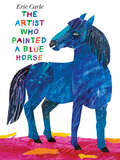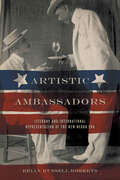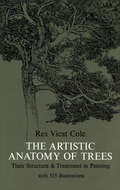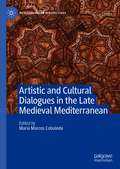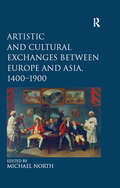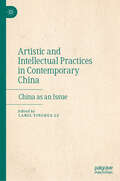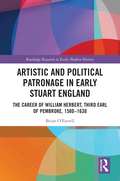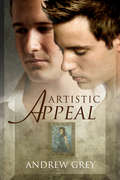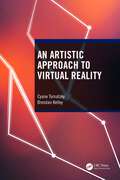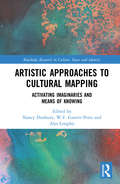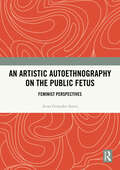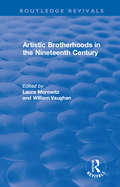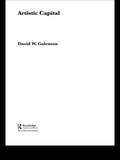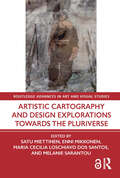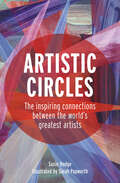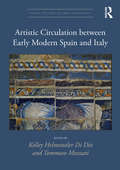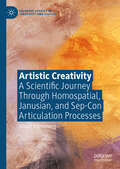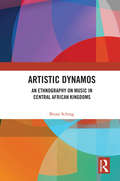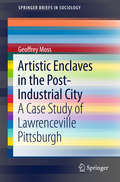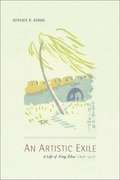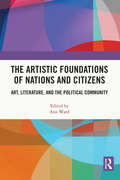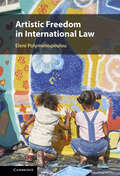- Table View
- List View
The Artist Who Painted a Blue Horse
by Eric CarleA brilliant new Eric Carle picture book for the artist in us all Every child has an artist inside them, and this vibrant picture book from Eric Carle will help let it out. The artist in this book paints the world as he sees it, just like a child. There's a red crocodile, an orange elephant, a purple fox and a polka-dotted donkey. More than anything, there's imagination. Filled with some of the most magnificently colorful animals of Eric Carle's career, this tribute to the creative life celebrates the power of art.
The Artist Who Painted a Blue Horse
by Eric CarleA brilliant new Eric Carle picture book for the artist in us allEvery child has an artist inside them, and this vibrant picture book from Eric Carle will help let it out. The artist in this book paints the world as he sees it, just like a child. There's a red crocodile, an orange elephant, a purple fox and a polka-dotted donkey. More than anything, there's imagination. Filled with some of the most magnificently colorful animals of Eric Carle's career, this tribute to the creative life celebrates the power of art.
The Artistic Activism of Elombe Brath
by Thomas AielloIn 1963, at the height of the southern civil rights movement, Cecil Brathwaite (1936–2014), under the pseudonym Cecil Elombe Brath, published a satire of Black leaders entitled Color Us Cullud! The American Negro Leadership Official Coloring Book. The book pillories a variety of Black leaders—from political figures like Adam Clayton Powell and Whitney Young to civil rights activists like Martin Luther King, Bayard Rustin, and John Lewis, and even entertainers like Sammy Davis Jr., Lena Horne, and Dick Gregory—critiquing the inauthenticity of movement leaders while urging a more radical approach to Black activism. Despite the strong illustrations and unique commentary presented in the coloring book, it has virtually disappeared from histories of the movement. The Artistic Activism of Elombe Brath restores the coloring book and its creator to a place of prominence in the historiography of the Black left. It begins with an analysis of Brath’s influences, describing his life and work including his development as a Black nationalist thinker and Black satirist. This volume includes Brath’s early works—illustrations for DownBeat magazine and Beat Jokes, Bop Humor, & Cool Cartoons—as well as the full run of his comic strip “Congressman Carter and Beat Nick Jackson” from the New York Citizen-Call and a complete edition of Color Us Cullud! itself. These illustrations are followed by annotations that frame and contextualize each of the coloring book’s entries. The book closes with selections from Brath’s art and political thinking via archival material and samples of his written work. Ultimately, this volume captures and restores a unique perspective on the civil rights movement often omitted from the historiography but vital to understanding its full scope.
Artistic Ambassadors: Literary and International Representation of the New Negro Era
by Brian Russell RobertsDuring the first generation of black participation in U.S. diplomacy in the late nineteenth and early twentieth centuries, a vibrant community of African American writers and cultural figures worked as U.S. representatives abroad. Through the literary and diplomatic dossiers of figures such as Frederick Douglass, James Weldon Johnson, Archibald and Angelina Grimké, W. E. B. Du Bois, Ida Gibbs Hunt, and Richard Wright, Brian Roberts shows how the intersection of black aesthetic trends and U.S. political culture both Americanized and internationalized the trope of the New Negro. This decades-long relationship began during the days of Reconstruction, and it flourished as U.S. presidents courted and rewarded their black voting constituencies by appointing black men as consuls and ministers to such locales as Liberia, Haiti, Madagascar, and Venezuela. These appointments changed the complexion of U.S. interactions with nations and colonies of color; in turn, state-sponsored black travel gave rise to literary works that imported international representation into New Negro discourse on aesthetics, race, and African American culture.Beyond offering a narrative of the formative dialogue between black transnationalism and U.S. international diplomacy, Artistic Ambassadors also illuminates a broader literary culture that reached both black and white America as well as the black diaspora and the wider world of people of color. In light of the U.S. appointments of its first two black secretaries of state and the election of its first black president, this complex representational legacy has continued relevance to our understanding of current American internationalism.
The Artistic Anatomy of Trees
by Rex V. ColeFor years greatly admired and widely used, this excellent text by one of Britain's foremost art instructors has achieved the status of a classic in its field. The author, also a noted landscape painter, offers complete and accurate instruction in painting and drawing trees to all serious artists — beginner or advanced, amateur or professional. Its extremely comprehensive and detailed coverage has earned this volume a permanent place in the libraries of landscape painters, students, and teachers. Every aspect of trees and how to depict them — in any style — is covered with unusual clarity and precision; problems of balancing tree groups, relations of light and shade, delicacy and weight, distance, sky apertures and their patterns, curves and straight lines in tree branches, tree color, the influence of special environmental factors (age, frost and snow, wind, moonlight), the effects of bud arrangements on the anatomy of trees, etc. Of special value is the very thorough and lucid analysis of tree anatomy: the proportion of boughs, branches, and twigs; the positioning of leaves on twigs; the form, texture, and color of leaves; leaf patterns; flower arrangement; stipules, bracts, buds, scales, spines, seedlings, the bark, and all the other essential details of structure. Specific information is given for each tree discussed: oaks, sycamores, willows, pines, maples, etc.; abstract and inaccurate generalizations are avoided. Nearly 500 illustrations by the author accompany the text, demonstrating all the anatomical features discussed. In addition, there are 48 full-page plates: magnificent landscape paintings and drawings by Giorgione, Rubens, Rembrandt, Van der Neer, Watteau, Hobbema, Turner, Gainsborough, Dupré, and many others, showing their compositional use of trees, their details in rendering, and similar material.
Artistic and Cultural Dialogues in the Late Medieval Mediterranean (Mediterranean Perspectives)
by María Marcos CobaledaThis book analyses the artistic and cultural legacy of Western Islamic societies and their interactions with Islamic, Christian and Jewish societies in the framework of the late medieval Mediterranean, from a range of multi-disciplinary perspectives. The book, organised in four parts, addresses the Andalusi legacy from its presence in the East and the West; analyses the relations and transfers between Al-Andalus and the artistic productions of the Christian kingdoms of the Iberian Peninsula; explores other manifestations of the Andalusi legacy in the fields of knowledge, construction, identity and religious studies; and reconsiders ornamental transfers and exchanges in artistic manifestations between East and West across the Mediterranean basin.Chapter 2 is open access under a CC BY 4.0 license.
Artistic and Cultural Exchanges between Europe and Asia, 1400-1900: Rethinking Markets, Workshops and Collections
by Michael NorthThe European expansion to Asia was driven by the desire for spices and Asian luxury products. Its results, however, exceeded the mere exchange of commodities and precious metals. The meeting of Asia and Europe signaled not only the beginnings of a global market but also a change in taste and lifestyle that influences our lives even today. Manifold kinds of cultural transfers evolved within a market framework that was not just confined to intercontinental and intra-Asiatic trade. In Europe and Asia markets for specific cultural products emerged and the transfers of objects affected domestic arts and craft production. Traditionally, relations between Europe and Asia have been studied in a hegemonic perspective, with Europe as the dominant political and economic centre. Even with respect to cultural exchange, the model of diffusion regarded Europe as the centre, and Asia the recipient, whereby Asian objects in Europe became exotica in the Kunst- und Wunderkammern. Conceptions of Europe and Asia as two monolithic regions emerged in this context. However, with the current process of globalization these constructions and the underlying models of cultural exchange have come under scrutiny. For this reason, the book focuses on cultural exchange between different European and Asian civilizations, whereby the reciprocal complexities of cultural transfers are at the centre of observation. By investigating art markets, workshops and collections in Europe and Asia the contributors exemplify the varieties of cultural exchange. The book examines the changing roles of Asian objects in European material culture and collections and puts a special emphasis on the reception of European visual arts in colonial settlements in Asia as well as in different Asian societies.
Artistic and Intellectual Practices in Contemporary China: China as an Issue
by Carol Yinghua LuThis edited volume is the first internationally available English translation of key lectures and essays delivered at Beijing’s Inside Out Art Museum over the past decade. The book elevates a chorus of voices from domestic and international intellectuals, artists, curators, and historians in a dialogue that reframes Chinese art from 1949 to the present.Part I offers critical academic complications of the story of Chinese art from the 1950s to the present as one singularly defined and stifled by political revolution. It traces important continuities and early examples of contemporary art practice to the Party’s birth and consolidation of power from the 1920s onwards. It relates the formation of contemporary art to the historical course of intellectual practice in China from 1949. Part II proposes China as an “issue” requiring historical interrogation rather than an inviolable entity. It questions the efficacy of “Asia” as a term, presents case studies of independentpublishers that challenged tightly crafted historical narratives, and wraps up with incisive reflections on the challenges confronting creatives and historians in China today.With chapters ranging from peer-reviewed scholarship to cuttingly humorous personal anecdotes, its contributing authors give rare, first-hand accounts of navigating pertinent historical and current situations, including censorship, China’s il/liberalism, and COVID-19. This book offers readers an ear to heretofore closed-door conversations in leading modern and contemporary art spaces.
Artistic and Political Patronage in Early Stuart England: The Career of William Herbert, Third Earl of Pembroke, 1580-1630
by Brian O'FarrellArtistic and Political Patronage in Early Stuart England explores the remarkable life and career of William Herbert, Third Earl of Pembroke. Pembroke was one of the most influential aristocrats during the reigns of Elizabeth I, James I and Charles I. He was a great patron, a prominent politician and electoral manager, an entrepreneur, and a gifted poet. Yet despite his influence and many talents, Pembroke’s life has been little studied by historians. Drawing on archival material, this book throws new light on Pembroke, and demonstrates just how significant he was during his lifetime. This book will appeal to scholars and students of early modern British history, as well as those interested in politics and patronage during the sixteenth and seventeenth centuries.
Artistic Appeal (Art Series #2)
by Andrew GreyAn Art Series novelBrian Watson knows close friends Gerald Young and Dieter Krumpf have an ulterior motive when they invite him to their Christmas party. Brian has taken over the case to secure the return of the famous painting called The Woman in Blue to Dieter, but they don't want Brian to be all work and no play. They intend to set him up with a friend, but he's not who catches Brian's eye. Instead, it's Nicolai, the deaf art restorer caring for the works already returned to Dieter. But pursuing Nicolai won't be easy. A year ago Nicolai had to fight to regain his independence after a bad break-up, and he's reluctant to give up his freedom a second time. Plus, Brian has competition in Justin, Nicolai's ex, who wants him back badly. Nicolai's reluctance isn't the only roadblock. Brian was married to a woman for almost ten years. Now he has to confess to his mother, his ex-wife, and his young daughter that he loves a man--all while conducting a potentially groundbreaking court case and trying to convince Nicolai that love isn't about co-dependence, it's about support.
An Artistic Approach to Virtual Reality
by Cyane Tornatzky Brendan KelleyA special quality about the medium of virtual reality is its immersive nature, allowing users to disengage from the physical world around them in order to fully interact with a digital environment. An Artistic Approach to Virtual Reality traces the lineage of artist/technologists who have worked with virtual reality in its infancy to the interactive virtual work of contemporary artists such as Laurie Anderson. Interlaced within a survey of artists whose works fit in the boundary of the interactive virtual medium, this book teases out what qualifies as interactive virtual artworks. The authors discuss the theories behind basic mechanics required to enter the virtual reality space and investigate theories around visual and embodied conceptual space. Key Features: · Explores theoretical and practical aspects of using virtual reality for artistic practice. · Includes examples and discussion of virtual reality artworks from award-winning artists. · Discusses topics relevant to virtual reality that are pertinent and persist throughout hardware and software changes. · Provides historical and contemporary discussion of virtual reality artistic works.
Artistic Approaches to Cultural Mapping: Activating Imaginaries and Means of Knowing (Routledge Research in Culture, Space and Identity)
by Nancy Duxbury W.F. Garrett-Petts Alys LongleyMaking space for imagination can shift research and community planning from a reflective stance to a "future forming" orientation and practice. Cultural mapping is an emerging discourse of collaborative, community-based inquiry and advocacy. This book looks at artistic approaches to cultural mapping, focusing on imaginative cartography. It emphasizes the importance of creative process that engages with the "felt sense" of community experiences, an element often missing from conventional mapping practices. International artistic contributions in this book reveal the creative research practices and languages of artists, a prerequisite to understanding the multi-modal interface of cultural mapping. The book examines how contemporary artistic approaches can challenge conventional asset mapping by animating and honouring the local, giving voice and definition to the vernacular, or recognizing the notion of place as inhabited by story and history. It explores the processes of seeing and listening and the importance of the aesthetic as a key component of community self-expression and self-representation. Innovative contributions in this book champion inclusion and experimentation, expose unacknowledged power relations, and catalyze identity formation, through multiple modes of artistic representation and performance. It will be a valuable resource for individuals involved with creative research methods, performance, and cultural mapping as well as social and urban planning.
An Artistic Autoethnography on the Public Fetus: Feminist Perspectives
by Anna Gonzalez SueroAn Artistic Autoethnography on the Public Fetus explores artistic work with the iconic image of the fetus and the personal consequences of the image by analyzing the so-called public fetus within a feminist approach.This book develops a deeply interdisciplinary body of research, engaging with feminist debates on reproductive technology and imagery, art theory, visual histories of anatomical imagery, cultural critiques of the myth of the artistic genius, Gestalt understandings of perception and memory, and anthropological theories of liminality. Through blurring the artistic with the scientific, it explores the potential of autoethnography to serve as a form of conscious raising through which to create new images and stories that counter the public fetus in support of reproductive autonomy and social justice.This book will be useful to feminist scholars who work with issues related to gender, reproduction, sexuality, and autoethnography. At the same time, the book will be of value to undergraduate and graduate students in gender studies as an example of how an autoethnographic process can make unrecognized experiences of gender known to a person.
Artistic Brotherhoods in the Nineteenth Century
by Laura Morowitz William VaughanThis title was first published in 2000. The nineteenth century saw the emergence of numerous artistic brotherhoods - groups of artists bound together in communal production, sharing spiritual and aesthetic aims. Although it is widely acknowledged that this is an unique feature of the period, there has not previously been a separate study of the phenomenon. This collection of essays provides a thorough and wide-ranging exploration of the issue. Situating artistic brotherhoods within their historical context, it offers unique insights into the social, political, economic and cultural milieu of the nineteenth century. It focuses on the most celebrated and influential brotherhoods, while also bringing to light lesser-known or forgotten artists. The essays explore the artistic fraternity from a wide variety of perspectives, probing issues of gender, identity, professional practices and artistic formation in Europe and the United States. This book investigates the Nazarenes, the Pre-Raphaelites, the Russian Abramatsova, the Primitifs, the Nabis as well as other leading groups. The book contains a substantial introduction, which establishes the key questions and issues surrounding the phenomena of the artistic brotherhood, including their relation to the larger artistic community, their association with other social and political organizations of the period, and the ways in which mythologies have been built around them in subsequent histories and recollections of the period.
Artistic Capital
by David GalensonAt what stage of their careers do great artists produce their most important work? In a series of studies that bring new insights and new dimensions to the study of artistic creativity, Galenson’s new book examines the careers of more than one hundred modern painters, poets and novelists to reveal a powerful relationship between age and artistic creativity. Analyzing the careers of major literary and artistic figures, such as Cézanne, van Gogh, Dickens, Hemingway and Plath, Galenson highlights the different methods by which artists have made innovations. Pointing to a new and richer history of the modern arts, this book is of interest, not only to humanists and social scientists, but to anyone interested in the nature of human creativity in general.
Artistic Cartography and Design Explorations Towards the Pluriverse (Routledge Advances in Art and Visual Studies)
by Satu Miettinen Enni Mikkonen Maria Cecilia Loschiavo dos Santos Melanie SarantouThis edited volume uses an interdisciplinary approach to art and design that not only reframes but also repositions agendas and actions to address fragmented global systems. Contributors explore the pluriverse of art and design through epistemological and methodological considerations. What kinds of sustainable ways are there for knowledge transfer, supporting plural agendas, finding novel ways for unsettling conversations, unlearning and learning and challenging power structures with marginalised groups and contexts through art and design? The main themes of the book are art and design methods, epistemologies and practices that provide critical, interdisciplinary, pluriversal and decolonial considerations. The book challenges the domination of the white logic of art and design and shifts away from the Anglo-European one-world system towards the pluriverse. The book will be of interest to scholars working in art history, visual studies, arts-based research, and design studies.
Artistic Circles: The Inspiring Connections Between the World's Greatest Artists
by Susie HodgeDiscover the fascinating connections between the world's greatest artists. Artistic Circles introduces some of the most inspirational stories of friendship, love, creativity and shared passions in the world of art. Whether through teaching, as in the case of Paul Klee and Anni Albers; a mutual muse, as seen in the flowers of Georgia O&’Keeffe and Takashi Murakami; or an inspirational romantic coupling like that of Lee Krasner and Jackson Pollock. In telling the tales of these creatives lives and achievements – each extraordinary and oftentimes ground-breaking – Susie Hodge exposes the fascinating web of connections that have fostered some of the world&’s art masterpieces. Some are well-known, whereas others span both time and place, linking pioneers in art in fascinating and unexpected ways. Illustrated in colourful tribute to each artists&’ unique style, Artistic Circles is an illuminating and celebratory account of some of the art world&’s most compelling visionaries. A perfect introduction for students, and a source of new and surprising stories for art lovers.
Artistic Circulation between Early Modern Spain and Italy (Visual Culture in Early Modernity)
by Kelley Helmstutler Di Dio Tommaso MozzatiThis collection of essays by major scholars in the field explores how the rich intersections between Italy and Spain during the early modern period resulted in a confluence of cultural ideals. Various means of exchange and convergence are explored through two main catalysts: humans—their trips or resettlements—and objects—such as books, paintings, sculptures, and prints. The visual and textual evidence of the transmission of ideas, iconographies and styles are examined, such as triumphal ephemera, treatises on painting, the social status of the artist, collections and their display, church decoration, and funerary monuments, providing a more nuanced understanding of the exchanges of styles, forms and ideals across southern Europe.
Artistic Citizenship: A Public Voice for the Arts
by Mary Schmidt CampbellArtistic Citizenship asks the question: how do people in the creative arts prepare for, and participate in, civic life? This volume, developed at NYU’s Tisch School, identifies the question of artistic citizenship to explore civic identity – the role of the artist in social and cultural terms. With contributions from many connected to the Tisch School including: novelist E.L. Doctorow, performance artist Karen Finley, theatre guru Richard Schechner, and cultural theorist Ella Shohat, this book is indispensable to anyone involved in arts education or the creation of public policy for the arts.
Artistic Creativity: A Scientific Journey Through Homospatial, Janusian, and Sep-Con Articulation Processes (Palgrave Studies in Creativity and Culture)
by Albert RothenbergThis book presents the creative processes in art throughout history and cultures. A specific cognitive function, the homospatial process, is extensively documented and described, as well as short and long term scientific research in artistic creation and its applications to aesthetic appreciation. Drawing on research in psychology of creativity, creative operations, and relationship of mental health and illness to creativity, the author delves into the psychology of creativity in art and other fields, and presents intensive and experimental studies of Rembrandt’s self-portraiture, controlled experimental assessment of prizewinning young artists, descriptions of three key creative processes, and in-depth exploration of the operation of the specific creative homospatial process in works of art throughout history. The book also presents specific controlled experimentation on use of the homospatial process, its application in the creation of clothing design, and two explorations of major artists and the relationship of mental health and creativity, ending with a reflection on the role and function of creativity in society.
Artistic Dynamos: An Ethnography On Music In Central African Kingdoms
by Brian SchragArtistic Dynamos: An Ethnography on Music in Central African Kingdoms uses stories and research from Ngiemboon communities of West Cameroon as touchstones for proposing new approaches to arts scholarship and community development. Building on the results of ethnographic research, artistic action is viewed through the lens of communication. This view brings a picture of increased cultural energy in the enactment of artistic genres—melodic, rhythmic, poetic, dramatic, visual, and performative. Schrag’s treatise will change how scholars across disciplines understand and engage with the arts. This volume offers methods for improved scholarship, resulting in communities living better lives. The author’s website contains the video and audio recordings discussed in the book, plus full-color versions of many photos and diagrams. www.ArtisticDynamos.com
Artistic Enclaves in the Post-Industrial City: A Case Study of Lawrenceville Pittsburgh (SpringerBriefs in Sociology)
by Geoffrey MossThis SpringerBriefs presents a case study and theoretical analysis of an artistic enclave that emerged within Lawrenceville Pittsburgh. It briefly describes the history of greater Pittsburgh, and Lawrenceville's transition from thriving blue-collar community to depopulated low-income neighborhood to gentrifying site of artistic and creative culture. It draws on multiple methods (e. g. , interviews, observations, and survey data) to discuss the advantages and disadvantages associated with being a Pittsburgh artist, and offer a detailed description of the origins and ongoing development of Lawrenceville's artistic enclave. It discusses this enclave in the context of sociological, historical, and interdisciplinary work on urban artistic communities (i. e. , bohemian and quasi-bohemian communities), and situates it within the larger urban artistic tradition, and within its contemporary urban context. It maintains that this enclave constitutes a successful (i. e. , sustainable) example of an artistic creative class enclave, a heuristic concept that clarifies and amends Richard Florida's brief commentary on contemporary urban artistic life. It concludes by offering policy suggestions for those who wish to promote such enclaves, and a preliminary critical appraisal of their potential impact on society.
An Artistic Exile: A Life of Feng Zikai (1898-1975)
by Geremie R. BarmeThis book, a blend of biography and criticism, tells the story of Feng Zikai (1898-1975), one of the most gifted and important artists to emerge from the politically tumultuous decades of the 1920s and 1930s. Geremie R. Barme provides a closely woven parallel history, that of the life of writer-artist Feng, who was also an essayist and a translator, and that of China's turbulent twentieth century.
The Artistic Foundations of Nations and Citizens: Art, Literature, and the Political Community
by Ann WardThis book examines politics through the lens of art and literature. Through discussion on great works of visual art, literature, and cultural representations of political thought in the medieval, early modern, and American eras, it explores the relevance of the nation-state to human freedom and flourishing, as well as the concept of citizenship and statesmanship that it implies, in contrast to that of the ‘global community’. The essays in this volume focus on shifting notions of various core political concepts like citizenship, republicanism, and nationalism from antiquity to the present-day to provide a systematic understanding of their evolving histories through Western Art and literature. It highlights works such as the Bayeux Tapestry, Shakespeare’s Henry V, Henry VI, and A Midsummer Night’s Dream, Twain’s Joan of Arc and Hermann’s Nichts als Gespenster, among several other canonical works of political interest. Further, it questions if we should now look beyond the nation-state to some form of tans-national, global community to pursue the human freedom desired by progressives, or look at smaller forms of community resembling the polis to pursue the friendship and nobility valued by the ancients. The volume will be invaluable to students and teachers of political science, especially political theory and philosophy, visual arts, and world literature.
Artistic Freedom in International Law
by Eleni PolymenopoulouThe book examines in detail the essence, nature and scope of artistic freedom as a human right. It explains the legal problems associated with the lack of a precise definition of the term 'art' and discusses the emergence of a distinct 'right' to artistic freedom under international law. Drawing on a variety of case-studies primarily from the field of visual arts, but also performance, street art and graffiti, it examines potentially applicable 'defences' for those types of artistic expression that are perceived as inappropriate, ugly, offensive, disturbing, or even obscene and transgressive. The book also offers a view on global controversies such as Charlie Hebdo and the Danish Cartoons, attempting to explain the subtleties of offenses related to religious sensibilities and beliefs. It also examines the legitimacy of restrictions on extremist expressions in the case of arts involving criminal arts, such as child pornography.

